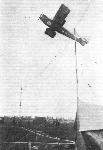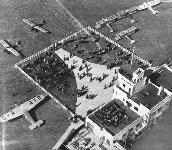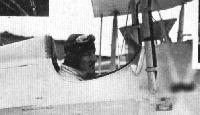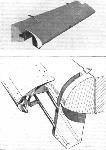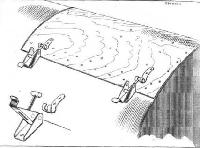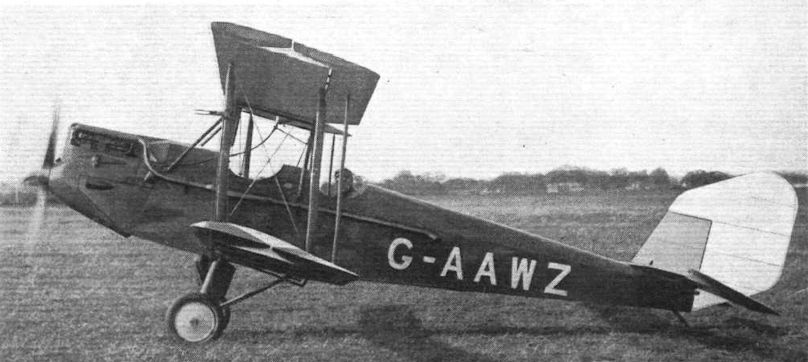
Варианты
- Simmonds - Spartan - 1928 - Великобритания
- Spartan - Arrow - 1930 - Великобритания
Spartan (Великобритания). Самолеты ранних типов
На заводе в Хэмпшире, Южная Англия, Оливер Симмондз спроектировал и построил в 1928 году прототип двухместного биплана Simmonds Spartan с мотором Cirrus III мощностью 95 л.с. Всего построили примерно 50 таких самолетов, почти половину из которых продали за пределы Великобритании. На самолеты ставили различные моторы мощностью от 80 до 120 л. с.
Самолеты выпускались компанией "Simmonds Aircraft Ltd", но успех Spartan привел к тому, что в 1930 году реорганизованная фирма получила название "Spartan Aircraft Ltd".
Первым изделием обновленной фирмы стал немного больший по размерам, чем предшественник, двухместный биплан Spartan Arrow с размахом крыла 9,32 м; первый полет он выполнил в 1930 году. Всего построено 15 самолетов с моторами мощностью 95-160 л.с. Эти машины эксплуатировались частными лицами и аэроклубами в Великобритании, странах Британского содружества и скандинавских странах.
Описание:
- Spartan (Великобритания). Самолеты ранних типов
- Flight, November 1930
THE SPARTAN "ARROW"
Фотографии
-
Flight 1930-11 / Flight
Регистрационный номер: G-AAWZ [9] THE SPARTAN "ARROW" (GIPSY II): This Side View illustrates well the pleasing lines of the machine. Note that the rudder is of a shape quite different from that of the older Spartans.
-
Flight 1930-07 / Flight
Регистрационный номер: G-AAWZ [9] A "Spartan Arrow": Mr. Andrews waits for Col. Lindsay Lloyd to drop the flag.
-
Flight 1930-09 / Flight
Регистрационный номер: G-AAWZ [9] THE SPARTAN "ARROW": This is the new version of the Spartan and was first shown in public in the King's Cup Race. Particular attention has been paid to the view from both cockpits.
-
Flight 1930-11 / Flight
Регистрационный номер: G-AAWZ [9] -
Flight 1930-11 / Flight
Регистрационный номер: G-AAWZ [9] THE SPARTAN "ARROW": Three-quarter front view. The engine is a "Gipsy II."
-
Flight 1932-09 / Flight
Регистрационный номер: G-AAWZ [9] The Cirrus-Hermes Engineering Co. whose latest engine the "Hermes IV" was described in FLIGHT for July 8, use a Spartan "Arrow" for their test work. Mr. J. V. Holman, their Sales Manager, is here seen beside the "Arrow."
-
Flight 1930-11 / Flight
Регистрационный номер: G-AAWZ [9] AN UNDERNEATH VIEW: The Spartan "Arrow" flying at Hamble
-
Flight 1930-10 / Flight
Регистрационный номер: G-AAWZ [9] A flying picture of the new Spartan "Arrow," which possesses several distinctive features - of which more anon.
-
Flight 1930-08 / Flight
Регистрационный номер: G-AAWZ [9] Mr. Andrews (Spartan-Arrow-Gipsy II) makes sure of clearing the take-off obstacle,
-
Flight 1931-07 / Flight
Регистрационный номер: G-ABHR An Aerial view taken just as the Prince of Wales stepped out of his Puss Moth. His second machine brought one of his equerries. The Band of H.M. Grenadier Guards can be seen on the roof of the Club House.
G-AAYR - Avro Six; G-ABNN, G-ABFY, G-ABDH - D.H. Puss Moth; G-ABAD, G-AAVY - D.H. Gipsy Moth; G-ABHR - Spartan ArrowДругие самолёты на фотографии: Avro Five / Type 619 / Six / Type 624 - Великобритания - 1929De Havilland Gipsy Moth / Moth X - Великобритания - 1928De Havilland Puss Moth / D.H.80 - Великобритания - 1929
-
Flight 1932-08 / Flight
Регистрационный номер: G-ABOB [3] THE LIMIT MAN GETS AWAY: Lt. Col. Strange ready to "give her the gun" when Mr. Reynolds shall drop his red flag.
-
Flight 1932-06 / Flight
Регистрационный номер: G-ABOB [3] ECHOES OF HENDON: Col. L. Strange takes his Spartan "Arrow" round the pylon in the true Hendon style, losing less than anyone on his turns.
-
Flight 1932-04 / Flight
Регистрационный номер: G-ABST FLIGHT-TESTING THE NEW NAPIER ENGINE: The first of these engines (6-cylinder in line air cooled, 150 h.p.) has been built into a "Spartan" aeroplane for the purpose of extensive flying tests. The machine is likely to visit, during the test period, several British aerodromes, and readers are advised to bear in mind the registration letters G-ABST. By way of mnemonic assistance we would suggest British Summer Time.
-
Aeroplane Monthly 1974-10 / P.Moss - British Airways (1)
Регистрационный номер: G-ABTR The Spartan Three-Seater II Coup used by Spartan Air Lines and later transferred to United Air Lines.
-
Мировая Авиация 240
Регистрационный номер: G-ABWP [5] Этот G-ABWP - последний построенный Spartan Arrow, самолет оснащен мотором Cirrus Hermes II мощностью 105 л. с. Взлетная масса - 839 кг, максимальная скорость - 171 км/ч.
-
Air-Britain Archive 1981-01
Регистрационный номер: G-ABWP [5] The sole remaining British-registered Spartan Arrow G-ABWP in blue and silver colours at Denham 21.9.62.
-
Jane's All the World Aircraft 1980 / Encyclopedia of Aviation - Aircraft A-Z - v5
Регистрационный номер: G-ABWP [5] Arrow two-seat light biplane, built by Spartan Aircraft Limited in the UK. Powered by a 78 kW (105 hp) Cirrus Hermes II engine.
-
Air Pictorial 1977-09
Регистрационный номер: G-ABWP [5] The last surviving Spartan Arrow, G-ABWP (105 h.p. Cirrus Hermes II), flying at the Sywell PFA Rally 2/7/77 piloted by Carl Butler. Over an 8 1/2-year period the engine was completely reconditioned by the Arrow's owner, Raymond Blain, and the airframe rebuilt by the M.P.M. Group led by Roy Mills who finally delivered it from Booker to Long Marston on 1st August 1976
-
Aeroplane Monthly 1977-09
Регистрационный номер: G-ABWP [5] Spartan Arrow G-ABWP was photographed during its visit to the Sywell rally on July 3, 1977.
-
Aeroplane Monthly 1998-10 / A.Welch - A Different World (2)
Регистрационный номер: G-ABWV [2] The author spotted Spartan Three-Seater G-ABWV, belonging to Rollason Aviation of Croydon, on a couple of occasions. It crashed and burned at Grantham, Lincolnshire, on September 28, 1933.
-
Aeroplane Monthly 1980-04 / Personal album
Регистрационный номер: G-ABWV [2] Also photographed on July 15, 1933, was the D.H.60 Moth G-ABOE. In the background can be seen a Spartan Three-Seater, probably G-ABWV.
Другие самолёты на фотографии: De Havilland Gipsy Moth / Moth X - Великобритания - 1928
-
Aeroplane Monthly 1983-02 / L.Curtis - Flying for all
Регистрационный номер: G-ACHF Though the Spartan Arrow was produced during 1930/1 eight were used by the Civil Air Guard during 1939.
-
Flight 1930-07 / Flight
THE most recent version of the Spartan the "Spartan Arrow" differs in that it has a Clark Y wing section, which reduces some of the interchangeability features slightly, but from which the machine may benefit otherwise. The "Arrow" is to be regarded as the sports type of Spartan. Fitted with Gipsy and Hermes engines.
-
Flight 1930-07 / Flight
THE BRITISH REPRESENTATIVES: So far all the British Competitors have been doing well in the Circuit of Europe. Here they are shown during their stay at Heston: 5, The Spartan Arrow.
-
Air-Britain Archive 1986-01
Регистрационный номер: G-ABOB [3] Portsmouth Municipal Aerodrome at home to an air display during 1932. Right of the apron with Fury G-ABSE is the PSIoW Avn Wessex G-ABVB (CofA 5.32) while the row below that includes Widgeon G-AADE (w/o 9.32). Also identifiable are Sports Avian G-AAWI, Moths G-AAIM, G-AAJJ, Arrow G-ABOB and Klemm L.27a G-ABOP; several rows of Furies lead to the nearest row with two Harts (?), Vickers Virginia, Imperial Airways Argosy G-AACI, Desoutter G-AAZI and Fokker F.VIIa G-EBTS all visible.
Другие самолёты на фотографии: Armstrong Whitworth Argosy - Великобритания - 1926Avro Avian / Type 594/616 - Великобритания - 1926De Havilland Gipsy Moth / Moth X - Великобритания - 1928Fokker F.VII / C-2 / F.XIV - Нидерланды - 1924Hawker Fury - Великобритания - 1931Hawker Hart - Великобритания - 1928Klemm L.25 - L.28 Swallow - Германия - 1927Koolhoven FK-41 - Нидерланды - 1928Vickers Virginia - Великобритания - 1922Westland Wessex / Westland IV - Великобритания - 1929Westland Widgeon - Великобритания - 1924
-
Flight 1931-07 / Flight
The Spartan "Arrow" Seaplane (Hermes II) which has recently been supplied to the Hon. A. F. Guiness, who has disposed of his Moth (Hermes II) which was fitted with the Short Amphibian undercarriage.
-
Flight 1931-06 / Flight
SEEN AT HESTON: FIt.-Lt. Stainforth gets ready for the race in his Spartan.
-
Flight 1930-11 / Flight
THE SLOT UNIT: The photograph shows the complete unit, while the sketch illustrates the torque tube which ensures parallel opening of the slot.
-
Flight 1930-11 / Flight
THE VERY NEAT PETROL TANK: The photograph shows the centre-section with tank in place, while the sketches illustrate the fastening of the tank, and also the locking of the pin used in the wing folding.
-
Flight 1930-11 / Flight
A NEAT CLIP: The sketch illustrates the clip on the door of the luggage locker, but the same type of clip is used elsewhere.
-
Flight 1930-11 / Flight
INTERCHANGEABILITY: This diagrammatic view shows how the two parts, A and B, of the trailing portion of the wing can be used in any position. The wing tip can be fitted at either end of the wing. The type of hinge employed for the aileron and trailing edge is shown at H, while the two smaller insets show a spar section and the construction of a wing rib.
-
Flight 1930-11 / Flight
ON THE SPARTAN "ARROW": The new lower plane wing root is braced from the fuselage, with which it is integral, by two struts.
- Фотографии








